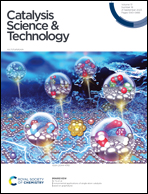Organic additive for the selective C2-product formation on Cu(100): a density functional theory mechanistic study†
Abstract
Electrochemical CO2 reduction is a promising approach to increase the chemical feedstock of energetically valuable products, especially ethylene and ethanol. In this regard, Cu catalysts are promising, but they suffer from poor intermediate adsorption. Polymer/organic additives can be utilized to tune the active center of Cu catalysts. DFT calculations have been performed considering urea and formamide modified Cu(100) surfaces to produce C2 products and the results are compared with the pure Cu(100) surface. Activation barrier analysis and reaction free energy changes determine the plausible reaction mechanism. The changes in the electronic properties of Cu(100) in the presence of formamide and urea are emphasized. The role of the hydrogen bonding interaction in the reaction free energy change and activation barriers is highlighted. Further, the role of carbonyl and –NH2 groups of the additives is studied. Overall, this work signifies the importance of acidic protons in improving the catalytic activity toward CO2 conversion to C2 products.



 Please wait while we load your content...
Please wait while we load your content...